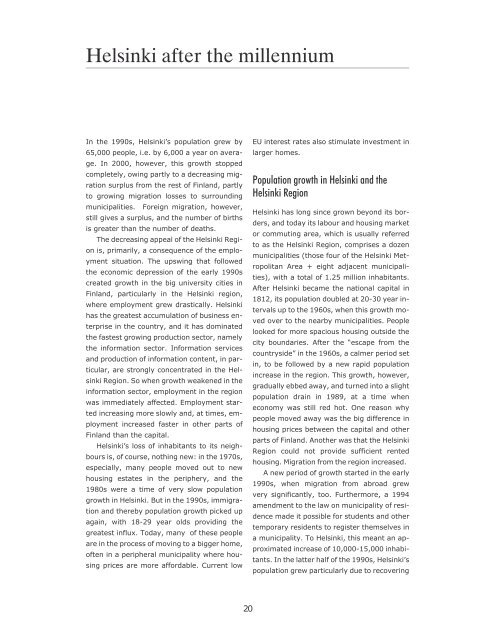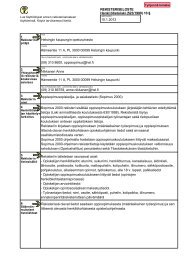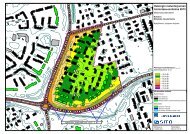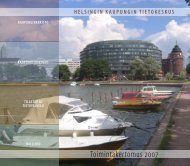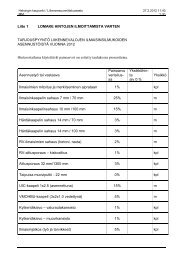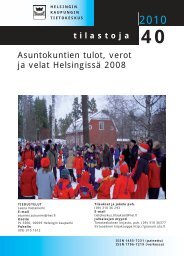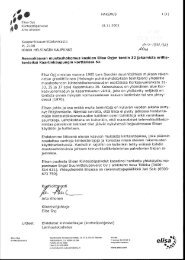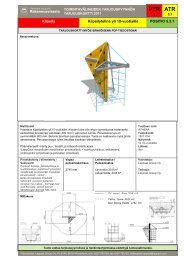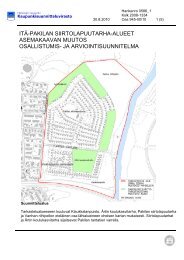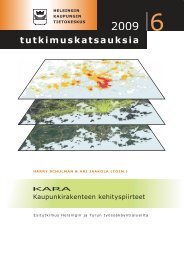Helsinki alueittain 2004 verkkojulkaisuja
Helsinki alueittain 2004 verkkojulkaisuja
Helsinki alueittain 2004 verkkojulkaisuja
You also want an ePaper? Increase the reach of your titles
YUMPU automatically turns print PDFs into web optimized ePapers that Google loves.
<strong>Helsinki</strong> after the millennium<br />
In the 1990s, <strong>Helsinki</strong>’s population grew by<br />
65,000 people, i.e. by 6,000 a year on average.<br />
In 2000, however, this growth stopped<br />
completely, owing partly to a decreasing migration<br />
surplus from the rest of Finland, partly<br />
to growing migration losses to surrounding<br />
municipalities. Foreign migration, however,<br />
still gives a surplus, and the number of births<br />
is greater than the number of deaths.<br />
The decreasing appeal of the <strong>Helsinki</strong> Region<br />
is, primarily, a consequence of the employment<br />
situation. The upswing that followed<br />
the economic depression of the early 1990s<br />
created growth in the big university cities in<br />
Finland, particularly in the <strong>Helsinki</strong> region,<br />
where employment grew drastically. <strong>Helsinki</strong><br />
has the greatest accumulation of business enterprise<br />
in the country, and it has dominated<br />
the fastest growing production sector, namely<br />
the information sector. Information services<br />
and production of information content, in particular,<br />
are strongly concentrated in the <strong>Helsinki</strong><br />
Region. So when growth weakened in the<br />
information sector, employment in the region<br />
was immediately affected. Employment started<br />
increasing more slowly and, at times, employment<br />
increased faster in other parts of<br />
Finland than the capital.<br />
<strong>Helsinki</strong>’s loss of inhabitants to its neighbours<br />
is, of course, nothing new: in the 1970s,<br />
especially, many people moved out to new<br />
housing estates in the periphery, and the<br />
1980s were a time of very slow population<br />
growth in <strong>Helsinki</strong>. But in the 1990s, immigration<br />
and thereby population growth picked up<br />
again, with 18-29 year olds providing the<br />
greatest influx. Today, many of these people<br />
are in the process of moving to a bigger home,<br />
often in a peripheral municipality where housing<br />
prices are more affordable. Current low<br />
EU interest rates also stimulate investment in<br />
larger homes.<br />
Population growth in <strong>Helsinki</strong> and the<br />
<strong>Helsinki</strong> Region<br />
<strong>Helsinki</strong> has long since grown beyond its borders,<br />
and today its labour and housing market<br />
or commuting area, which is usually referred<br />
to as the <strong>Helsinki</strong> Region, comprises a dozen<br />
municipalities (those four of the <strong>Helsinki</strong> Metropolitan<br />
Area + eight adjacent municipalities),<br />
with a total of 1.25 million inhabitants.<br />
After <strong>Helsinki</strong> became the national capital in<br />
1812, its population doubled at 20-30 year intervals<br />
up to the 1960s, when this growth moved<br />
over to the nearby municipalities. People<br />
looked for more spacious housing outside the<br />
city boundaries. After the “escape from the<br />
countryside” in the 1960s, a calmer period set<br />
in, to be followed by a new rapid population<br />
increase in the region. This growth, however,<br />
gradually ebbed away, and turned into a slight<br />
population drain in 1989, at a time when<br />
economy was still red hot. One reason why<br />
people moved away was the big difference in<br />
housing prices between the capital and other<br />
parts of Finland. Another was that the <strong>Helsinki</strong><br />
Region could not provide sufficient rented<br />
housing. Migration from the region increased.<br />
A new period of growth started in the early<br />
1990s, when migration from abroad grew<br />
very significantly, too. Furthermore, a 1994<br />
amendment to the law on municipality of residence<br />
made it possible for students and other<br />
temporary residents to register themselves in<br />
a municipality. To <strong>Helsinki</strong>, this meant an approximated<br />
increase of 10,000-15,000 inhabitants.<br />
In the latter half of the 1990s, <strong>Helsinki</strong>’s<br />
population grew particularly due to recovering<br />
20


